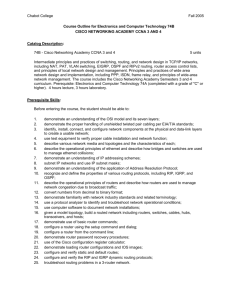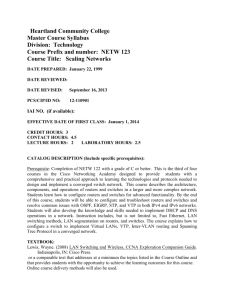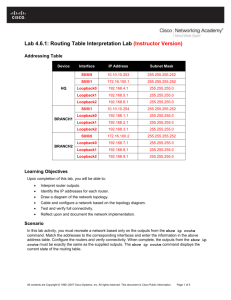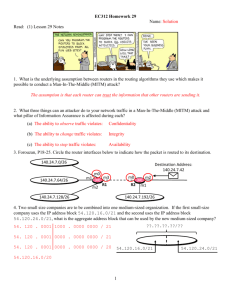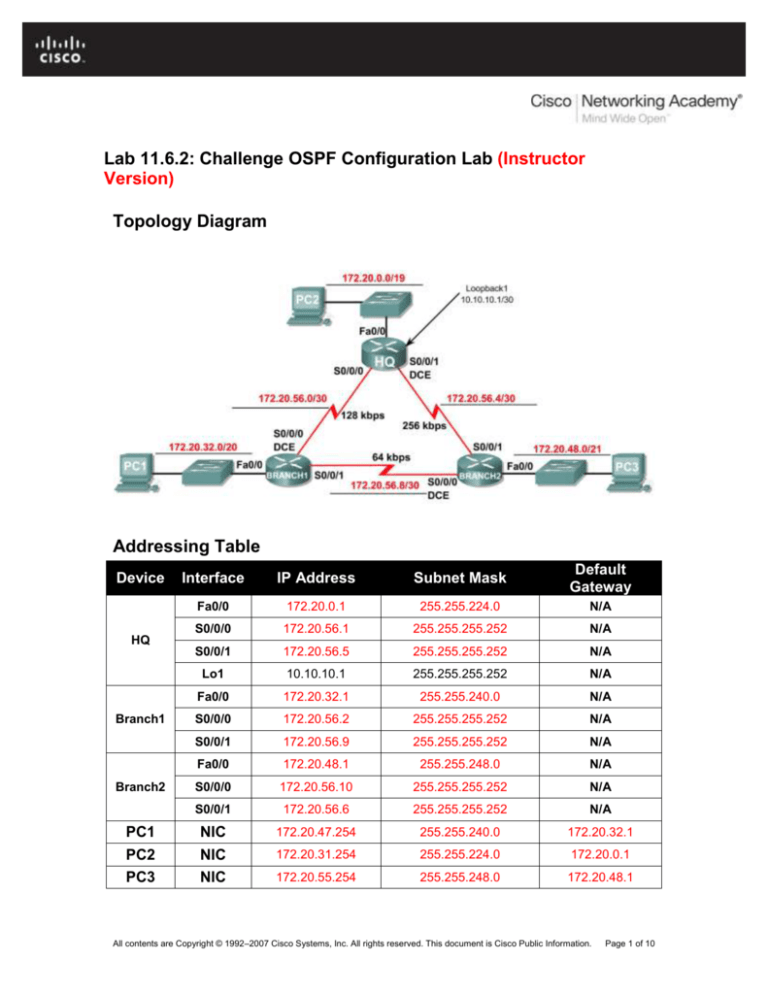
Lab 11.6.2: Challenge OSPF Configuration Lab (Instructor
Version)
Topology Diagram
Addressing Table
Device
HQ
Branch1
Branch2
PC1
PC2
PC3
Interface
IP Address
Subnet Mask
Default
Gateway
Fa0/0
172.20.0.1
255.255.224.0
N/A
S0/0/0
172.20.56.1
255.255.255.252
N/A
S0/0/1
172.20.56.5
255.255.255.252
N/A
Lo1
10.10.10.1
255.255.255.252
N/A
Fa0/0
172.20.32.1
255.255.240.0
N/A
S0/0/0
172.20.56.2
255.255.255.252
N/A
S0/0/1
172.20.56.9
255.255.255.252
N/A
Fa0/0
172.20.48.1
255.255.248.0
N/A
S0/0/0
172.20.56.10
255.255.255.252
N/A
S0/0/1
172.20.56.6
255.255.255.252
N/A
NIC
NIC
NIC
172.20.47.254
255.255.240.0
172.20.32.1
172.20.31.254
255.255.224.0
172.20.0.1
172.20.55.254
255.255.248.0
172.20.48.1
All contents are Copyright © 1992–2007 Cisco Systems, Inc. All rights reserved. This document is Cisco Public Information.
Page 1 of 10
CCNA Exploration
Routing Protocols and Concepts: OSPF
Lab 11.6.2: Challenge OSPF Configuration Lab
Learning Objectives
Upon completion of this lab, you will be able to:
Create an efficient VLSM design given requirements
Assign appropriate addresses to interfaces and document
Cable a network according to the Topology Diagram
Erase the startup configuration and reload a router to the default state
Configure routers including OSPF
Configure and propagate a static default route
Verify OSPF operation
Test and verify full connectivity
Reflect upon and document the network implementation
Scenario
In this lab activity, you will be given a network address that must be subnetted using VLSM to
complete the addressing of the network shown in the Topology Diagram. A combination OSPF
routing and static routing will be required so that hosts on networks that are not directly
connected will be able to communicate with each other. OSPF area ID of 0 and process ID of 1
will be used in all OSPF configurations.
Task 1: Subnet the Address Space.
Step 1: Examine the network requirements.
The addressing for the Network has the following requirements.
The 172.20.0.0/16 network must be subnetted to provide addresses for the LANs and
serial links.
o The HQ LAN will require 8000 addresses
o The Branch1 LAN will require 4000 addresses
o The Branch2 LAN will require 2000 addresses
o The links between the routers will require two addresses for each link
The loopback address representing the link between the HQ router and the ISP will use
the 10.10.10.0/30 network.
Step 2: Consider the following questions when creating your network design.
How many subnets need to be created from the 172.20.0.0/16 network? ___6____
How many total IP addresses are required from the 172.20.0.0/16 network? ___14006_____
What subnet mask will be used for the HQ LAN subnet? ___255.255.224.0 or /19_____
What is the maximum number of host addresses that could be used on this subnet?
___8190_____
What subnet mask will be used for the Branch1 LAN subnet? ___255.255.240.0 or /20_____
All contents are Copyright © 1992–2007 Cisco Systems, Inc. All rights reserved. This document is Cisco Public Information.
Page 2 of 10
CCNA Exploration
Routing Protocols and Concepts: OSPF
Lab 11.6.2: Challenge OSPF Configuration Lab
What is the maximum number of host addresses that could be used on this subnet?
___4094_____
What subnet mask will be used for the Branch2 LAN subnet? ___255.255.248.0 or /21_____
What is the maximum number of host addresses that could be used on this subnet?
___2046_____
What subnet mask will be used for the links between the three routers?
___255.255.255.252 or /30_____
What is the maximum number of host addresses that could be used on each of these subnets?
___2_____
Step 3: Assign subnetwork addresses to the Topology Diagram.
1. Assign subnet 0 of the 172.20.0.0/16 network to the HQ LAN subnet. What is the network
address of this subnet? ___172.20.0.0/19_____
2. Assign subnet 1 of the 172.20.0.0/16 network to the Branch1 LAN subnet. What is the
network address of this subnet? ___172.20.32.0/20_____
3. Assign subnet 2 of the 172.20.0.0/16 network to the Branch2 LAN subnet. What is the
network address of this subnet? ___172.20.48.0/21_____
4. Assign subnet 3 of the 172.20.0.0/16 network to the link between the HQ and Branch1
routers. What is the network address of this subnet? ___172.20.56.0 /30_____
5. Assign subnet 4 of the 172.20.0.0/16 network to the link between the HQ and Branch2
routers. What is the network address of this subnet? ___172.20.56.4 /30_____
6. Assign subnet 5 of the 172.20.0.0/16 network to the link between the Branch1 and
Branch2 routers. What is the network address of this subnet? ___172.20.56.8 /30_____
Task 2: Determine Interface Addresses.
Assign appropriate addresses to the device interfaces.
1. Assign the first valid host address in the 10.10.10.0/30 network to the Loopback 1
interface on the HQ router.
2. Assign the first valid IP address of the HQ LAN network to the LAN interface of the HQ
router.
3. Assign the last valid IP address of the HQ LAN network to PC2.
4. Assign the first valid IP address of the Branch1 LAN network to the LAN interface of the
Branch1 router.
5. Assign the last valid IP address of the Branch1 LAN network to PC1.
All contents are Copyright © 1992–2007 Cisco Systems, Inc. All rights reserved. This document is Cisco Public Information.
Page 3 of 10
CCNA Exploration
Routing Protocols and Concepts: OSPF
Lab 11.6.2: Challenge OSPF Configuration Lab
6. Assign the first valid IP address of the Branch2 LAN network to the LAN interface of the
Branch2 router.
7. Assign the last valid IP address of the Branch2 LAN network to PC3.
8. Assign the first valid IP address of the HQ to Branch1 link network to the Serial 0/0/0
interface of the HQ router.
9. Assign the last valid IP address of the HQ to Branch1 link network to the Serial0/0/0
interface of the Branch router.
10. Assign the first valid IP address of the HQ to Branch2 link network to the Serial 0/0/1
interface of the HQ router.
11. Assign the last valid IP address of the HQ to Branch2 link network to the Serial0/0/1
interface of the Branch2 router.
12. Assign the first valid IP address of the Branch1 to Branch2 link network to the Serial 0/0/1
interface of the Branch1 router.
13. Assign the last valid IP address of the Branch1 to Branch2 link network to the Serial0/0/0
interface of the Branch2 router.
Document the addresses to be used in the table provided under the Topology Diagram.
Task 3: Prepare the Network.
Step 1: Cable a network that is similar to the one in the Topology Diagram.
You can use any current router in your lab as long as it has the required interfaces as shown in
the topology.
Step 2: Clear any existing configurations on the routers.
Task 4: Perform Basic Router Configurations.
Perform basic configuration of the BRANCH, HQ, and ISP routers according to the following
guidelines:
1. Configure the router hostname.
2. Disable DNS lookup.
3. Configure an EXEC mode password.
4. Configure a message-of-the-day banner.
5. Configure a password for console connections.
6. Configure a password for VTY connections.
7. Synchronize unsolicited messages and debug output with solicited output and prompts
for the console and virtual terminal lines.
8. Configure an EXEC timeout of 15 minutes.
All contents are Copyright © 1992–2007 Cisco Systems, Inc. All rights reserved. This document is Cisco Public Information.
Page 4 of 10
CCNA Exploration
Routing Protocols and Concepts: OSPF
Lab 11.6.2: Challenge OSPF Configuration Lab
Task 5: Configure and Activate Serial and Ethernet Addresses.
Step 1: Configure the interfaces on the HQ, Branch1, and Branch2 routers with the IP
addresses from the table provided under the Topology Diagram.
When you have finished, be sure to save the running configuration to the NVRAM of the router.
Step 2: Configure the Ethernet interfaces of PC1, PC2, and PC3 with the IP addresses from
the table provided under the Topology Diagram.
Step 3: Configure the correct bandwidth for the serial interfaces on the Branch 1 router.
What commands are required to accomplish this?
________________configure terminal__________________________________________
________________interface serial0/0/0_______________________________________
________________bandwidth 128_______________________________________________
________________interface serial 0/0/1_____________________________________
________________bandwidth 64________________________________________________
_____________________________________________________________________________
Step 4: Configure the correct bandwidth for the serial interfaces on the Branch 2 router.
What commands are required to accomplish this?
________________configure terminal__________________________________________
________________interface serial0/0/0_______________________________________
________________bandwidth 64________________________________________________
________________interface serial 0/0/1_____________________________________
________________bandwidth 256_______________________________________________
_____________________________________________________________________________
All contents are Copyright © 1992–2007 Cisco Systems, Inc. All rights reserved. This document is Cisco Public Information.
Page 5 of 10
CCNA Exploration
Routing Protocols and Concepts: OSPF
Lab 11.6.2: Challenge OSPF Configuration Lab
Step 5: Configure the correct bandwidth for the serial interfaces on the HQ router.
What commands are required to accomplish this?
________________configure terminal__________________________________________
________________interface serial0/0/0_______________________________________
________________bandwidth 128_______________________________________________
________________interface serial 0/0/1_____________________________________
________________bandwidth 256_______________________________________________
_____________________________________________________________________________
Task 6: Verify Connectivity to Next Hop Device.
You should NOT have connectivity between end devices yet. However, you can test connectivity
between two routers and between and end device and its default gateway.
Step 1: Verify that the HQ, Branch1, and Branch2 routers can ping each of the neighboring
routers across the WAN links.
Step 2: Verify that PC1, PC2, and PC3 can ping their respective default gateway.
Task 7: Configure OSPF Routing on the Branch1 Router.
Step 1: Consider the networks that need to be included in the OSPF updates that are sent
out by the Branch1 router.
What directly connected networks are present in the Branch1 routing table?
______________________________ 172.20.32.0/20___________________________________
______________________________ 172.20.56.0/30___________________________________
_______________________________172.20.56.8/30__________________________________
What commands are required to enable OSPF and include the connected networks in the routing
updates?
________________router ospf 1_______________________________________________
________________network 172.20.32.0 0.0.15.255 area 0_____________________
________________network 172.20.56.0 0.0.0.3 area 0________________________
________________network 172.20.56.8 0.0.0.3 area 0________________________
_____________________________________________________________________________
All contents are Copyright © 1992–2007 Cisco Systems, Inc. All rights reserved. This document is Cisco Public Information.
Page 6 of 10
CCNA Exploration
Routing Protocols and Concepts: OSPF
Lab 11.6.2: Challenge OSPF Configuration Lab
Are there any router interfaces that do not need to have OSPF updates sent out? ____Yes___
What command is used to disable OSPF updates on these interfaces?
____passive-interface FastEthernet0/0____________________________________
Task 8: Configure OSPF and Static Routing on the HQ Router.
Step 1: Consider the type of static routing that is needed on HQ.
A static default route will need to be configured to send all packets with destination addresses
that are not in the routing table to the loopback address representing the link between the HQ
router and the ISP. What command is needed to accomplish this?
________________________ip route 0.0.0.0 0.0.0.0 loopback1________________
What directly connected networks are present in the HQ routing table?
______________________________ 10.10.10.0/30____________________________________
______________________________ 172.20.0.0/19____________________________________
______________________________ 172.20.56.0/30___________________________________
______________________________ 172.20.56.4/30___________________________________
_____________________________________________________________________________
Will the networks of the HQ LAN and the links between the Branch 1 and Branch2 routers need to
have the subnet mask information included in the network statements? ___yes_____
What commands are required to enable OSPF and include the appropriate networks in the
routing updates?
________________router ospf 1_______________________________________________
________________network 172.20.0.0 0.0.31.255 area 0_____________________
________________network 172.20.56.0 0.0.0.3 area 0________________________
________________network 172.20.56.4 0.0.0.3 area 0________________________
_____________________________________________________________________________
Are there any router interfaces that do not need to have OSPF updates sent out? ____Yes___
What command is used to disable OSPF updates on these interfaces?
____passive-interface FastEthernet0/0____________________________________
____passive-interface Loopback1___________________________________________
All contents are Copyright © 1992–2007 Cisco Systems, Inc. All rights reserved. This document is Cisco Public Information.
Page 7 of 10
CCNA Exploration
Routing Protocols and Concepts: OSPF
Lab 11.6.2: Challenge OSPF Configuration Lab
The HQ router needs to send the default route information to the Branch1 and Branch2 routers in
the OSPF updates. What command is used to configure this?
____ default-information originate____________________________________
Task 9: Configure OSPF Routing on the Branch2 Router.
Step 1: Consider the networks that need to be included in the OSPF updates that are sent
out by the Branch2 router.
What directly connected networks are present in the Branch2 routing table?
______________________________172.20.48.0/21___________________________________
______________________________172.20.56.4/30___________________________________
______________________________172.20.56.8/30___________________________________
What commands are required to enable OSPF and include the connected networks in the routing
updates?
________________router ospf 1_______________________________________________
________________network 172.20.48.0 0.0.7.255 area 0_____________________
________________network 172.20.56.4 0.0.0.3 area 0________________________
________________network 172.20.56.8 0.0.0.3 area 0________________________
_____________________________________________________________________________
Are there any router interfaces that do not need to have OSPF updates sent out? ____Yes___
What command is used to disable OSPF updates on these interfaces?
____passive-interface FastEthernet0/0____________________________________
Task 10: Verify the Configurations
Answer the following questions to verify that the network is operating as expected.
From PC1, is it possible to ping PC2? _____Yes_______
From PC1, is it possible to ping the PC3? _____Yes_______
The answer to the above questions should be ‘yes’. If any of the above pings failed, check your
physical connections and configurations. Refer to your basic troubleshooting techniques used in
the [Chapter 1] labs.
All contents are Copyright © 1992–2007 Cisco Systems, Inc. All rights reserved. This document is Cisco Public Information.
Page 8 of 10
CCNA Exploration
Routing Protocols and Concepts: OSPF
Lab 11.6.2: Challenge OSPF Configuration Lab
What OSPF routes are present in the routing table of the Branch1 router?
______________172.20.0.0/19 [110/782] via 172.20.56.1_______________________________
______________172.20.48.0/21 [110/1172] via 172.20.56.1_____________________________
______________172.20.56.4/30 [110/1171] via 172.20.56.1_____________________________
______________0.0.0.0/0 [110/1] via 172.20.56.1_____________________________________
_____________________________________________________________________________
What is the gateway of last resort in the routing table of the Branch1 router?
_____________________172.20.56.1 to network 0.0.0.0_______________________________
What OSPF routes are present in the routing table of the HQ router?
______________172.20.32.0/20 [110/782] via 172.20.56.2______________________________
______________172.20.48.0/21 [110/391] via 172.20.56.6______________________________
______________172.20.56.8/30 [110/1952] via 172.20.56.6_____________________________
______________0.0.0.0/0 [110/1] via 172.20.56.1_____________________________________
_____________________________________________________________________________
What is the gateway of last resort in the routing table of the HQ router?
_____________________0.0.0.0 to network 0.0.0.0_______________________________
What OSPF routes are present in the routing table of the Branch2 router?
______________172.20.0.0/19 [110/391] via 172.20.56.5_______________________________
______________172.20.32.0/20 [110/1172] via 172.20.56.5_____________________________
______________172.20.56.0/30 [110/1171] via 172.20.56.5_____________________________
______________0.0.0.0/0 [110/1] via 172.20.56.5_____________________________________
_____________________________________________________________________________
What is the gateway of last resort in the routing table of the Branch2 router?
_____________________172.20.56.5 to network 0.0.0.0_______________________________
All contents are Copyright © 1992–2007 Cisco Systems, Inc. All rights reserved. This document is Cisco Public Information.
Page 9 of 10
CCNA Exploration
Routing Protocols and Concepts: OSPF
Lab 11.6.2: Challenge OSPF Configuration Lab
Task 11: Reflection
On PC1, use the tracert command to examine the route that is used between PC1 and PC3.
What are the hops in the route to PC3?
_____172.20.32.1, the FastEthernet0/0 interface of the Branch 1 router.____________________
_____172.20.56.1, the Serial0/0/0 interface of the HQ router._____________________________
_____172.20.56.6, the Serial0/0/1 interface of the Branch 2 router.________________________
_____172.20.55.254, the IP address of PC3.__________________________________________
Is this the least number of hops that can be used to reach PC3? _____No_______
If the answer is no, why is a path with more than the minimum amount of hops used?
_____________________________________________________________________________
_____________________________________________________________________________
_____________________________________________________________________________
_____________________________________________________________________________
_____________________________________________________________________________
_____________________________________________________________________________
The serial connection between the Branch1 and HQ routers and the connection between the HQ
and Branch 2 routers have a higher bandwidth that the link between the Branch 1 and Branch 2
routers. Routes with higher bandwidth values have a lower calculated cost. The route with the
lowest cost is chosen as the route to the Branch 2 LAN.
Task 12: Documentation
On each router, capture the following command output to a text (.txt) file and save for future
reference.
show running-config
show ip route
show ip interface brief
show ip protocols
If you need to review the procedures for capturing command output, refer to Lab 1.5.1
Task 13: Clean Up
Erase the configurations and reload the routers. Disconnect and store the cabling. For PC hosts
that are normally connected to other networks (such as the school LAN or to the Internet),
reconnect the appropriate cabling and restore the TCP/IP settings.
All contents are Copyright © 1992–2007 Cisco Systems, Inc. All rights reserved. This document is Cisco Public Information.
Page 10 of 10




